Squashing the Tenkara Casting Myth
There is a huge myth about tenkara casting. Many – otherwise sensible – fly fishers THINK that you just dangle a fly from a tenkara rod (and then either “dap” it on the water or track it like a Czech nymph). I’m here to beat that misunderstanding to death...
and as a side benefit – help you improve your cast with some step by step instructions - Scroll Down for Lessons ↓↓↓
The truth is, tenkara casting is one of the most important and satisfying parts of the whole activity. I easily put it on a par with regular fly casting (which I’m very fond of too). I’ve fly fished INTENSIVELY for over 30 years and I need to tell you that high-level tenkara casting is IMHO more difficult to master than regular “rod & reel” fly casting. If you’re already on board with this, feel free to scroll down to the Tenkara Casting Tips below.
But if you like a good argument…
None of the above is to say that (with either fly rod & reel OR tenkara) you can’t lob out bead-head nymphs and catch fish right away. That is definitely possible – and is actually positively advisable when getting newcomers into all forms of fly fishing. At the same time, it’s good to have higher levels to progress to so that you don’t get bored after “mastering it” on your first outing.
But who am I to talk? I guess you might already have seen that video above of me “poking the bear” with the slow-mo? Well, of course, I’m the first to admit that I ain’t perfect, plus a lot of those anti tenkara memes are good solid burns that get me laughing (“she said we should both start seeing other men” hahahaha) and there are certainly fly casters who can teach me plenty…At the same time, we’re going to fall out if you say that I “Can’t Cast” at all (expect sudden wedgies and oldschool playground Chinese Burns – don’t say I didn’t warn you).
Here’s the uncomfortable truth for a closed-minded fly-guy or gal
Even a #2 AFTM line loading a fly rod feels like the anchor chain from “Titanic” compared to 6 metres of 0.295 mm diameter level nylon plus a couple of metres of tippet. Also, here’s why you might want to learn how to cast that rig: Click here for the lowdown on casting #3 NYLON level line
Basically it is WAY easier to feel the rod loading and unloading on a western fly rod & reel rig. Added to that, the shorter a rod is, the more forgiving it is of timing and power-application mistakes (and tenkara rods are generally much longer than most fly rods).
Finally, if you ask casting instructors what they are most intimidated by when it comes to being assessed by casting qualification examiners – a good portion of them will say the “pick up and lay down” cast. There is simply no place to hide poor technique with that cast – and the “P.U.A.L.D” cast is pretty much every single tenkara cast you’re going to make (barring the odd roll cast or slingshot cast to cope with obstacles).
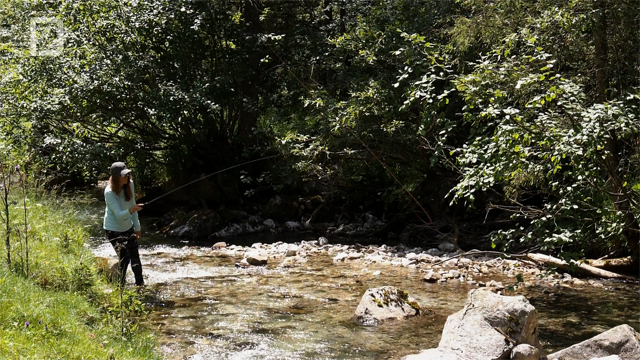
Tight loop cutting in under the branches by Susan – Nice work
Let’s get crystal clear on something – forming a proper fly-casting loop so that you can ACCURATELY deliver an unweighted wet-fly is the core of tenkara. It is one of the main things that often makes it more satisfying than competition-style nymphing. That accuracy should, ideally, allow you to drop a fly into a target about the size of an empty tuna can. You’ve already seen what it looks like when you are a talented student like Susan Skrupa (in the video at the top of this page and the freeze-frame above) after a week of tuition with JP and Vito. For the record, Susan (Skrup-dawg??) also fishes the salt-water for Striped Bass and throws flies on rod and reel for most anything that swims and will slam a fly – so she knows one end of a fly rod from the other. She might just kick my ass for the Skrup-dawg thing though…
Tenkara Casting vs Western Fly Rod Casting
A regular “Western” fly casting loop typically travels parallel to the water – although an interesting exception is the “fly first” Italian style of dry fly casting (but I’ll pick up on that in a second). The casting arc for fly rod and reel is usually also relatively long and typically finishes with the rod roughly parallel to the water’s surface. There is often a pause between back and forward casts to allow the line to straighten – and there can even be a “drift” element where the rod creates an even larger arc between the starting and finishing positions of the cast.

Typical Western Fly Rod & Reel cast – with wide arc (rod finishing flat) and loop travelling parallel to water
Finally, except for some competition style (French leaders or “duo”) approaches, a considerable amount of casting line ends up on the water.
In contrast, the ideal tenkara cast is usually angled down towards the water – just like the Italian style of casting. In both tenkara and Italian casting, the aim is to splat the fly onto the water so that the fish turns and reflexively gulps down the fly. The main difference is that, with Italian style fly casting, the (relatively heavy) fly line will land on the water soon after the fly touches down.
If possible, with tenkara casting, the casting line never touches down on the water. Instead just the fly and the right amount of tippet to deliver the fly to the eye-level of the fish land on the water. The aim is to create the perfect triangular “roof” arrangement of rod (on one side) and line (on the other) so that there is no disturbance between the angler and where the fly lands.
“Fly First” Casting Slo-Mo Demo
Before reading the step-by-step instructions below, it’s helpful to get a feel for two main points using this next video…
- Notice how only the fly lands on the water (and how the tippet and casting line don’t fall onto the water – they are held aloft to avoid spooking the fish).
- Also notice how there is zero “pause” between the back and forward cast. THIS IS DIFFICULT TO GET USED TO IF YOU ARE ALREADY A GOOD “WESTERN” FLY CASTER. The muscle memory is hard to overcome.
Casting Instructions: Basic to More Advanced
Level 1 Tenkara Casting
I know that there’ll be at least one Tenkara Guide who’ll roll his eyes at the idea of a prescriptive “rod arc” for a basic tenkara cast (I see you Rob!)…but here’s the thing, I feel it is possible to set up a fool-proof casting recipe that I know will work for anyone. When you’re starting to build confidence in a cast, I believe you need something – like this – that works right out of the box.
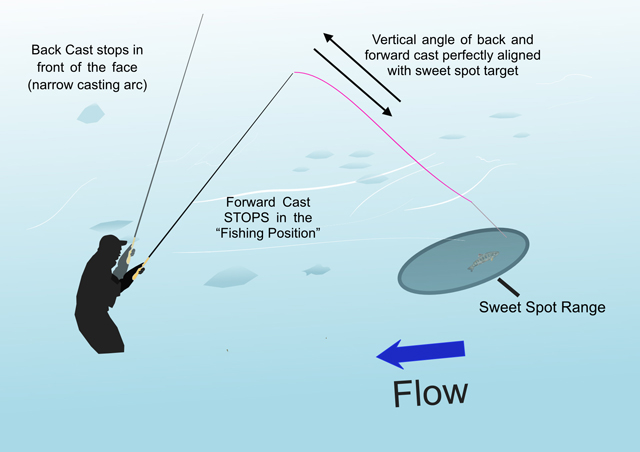
Look Carefully at the bent arm position on BOTH forward and back cast “stop” positions (and how short the arc is)
The diagram shows what I would recommend for a casting rig where the casting line (without tippet) reaches to somewhere within the range of the rod handle – or to just about a rod-handle-length beyond the butt. Onto that casting line, I’d normally attach a length of tippet that measures from the tips of your outstretched fingers on one hand to the opposite shoulder. On many people, that distance is somewhere in the region of 4ft (1.2m).
The great thing about measuring against your body is that if you’re a bit taller or a bit shorter, then your tippet length will scale perfectly in proportion to your height.
For that length of line, only a very short casting stroke is needed (your hand hardly moves) and you should cast mainly using the motion of your forearm (and limit the amount of movement in your wrist). The diagonal downwards alignment (see Susan’s video demo as well as the illustration above) should aim perfectly at the “sweet spot” range for your rig. This range is the distance at which, when the fly lands, it will drift back towards you quite naturally (or anchor easily in the current). If you cast beyond this, the line will drag the fly right back towards you too fast..If you cast too short, it will be difficult to set the hook (or you will be standing right on top of the fish – which in slower water is going to dramatically reduce your chances of catching fish.
The angle of the back-cast should be a seamless continuation of the line of the forward cast – which should drop the fly (and only the fly) into the middle of the sweet-spot range. Of course, sometimes trees get in the way (and there’s a great tactic to combat this featured in the video on this page: https://www.discovertenkara.com/blog/karasuninjatenkara/).
The two main mistakes that cause problems at this basic level are:
- A casting arc that is too wide
- Overpowering the cast (and/or gripping the rod handle WAY too tight)
The first mistake (wide arc) will prevent a proper flycasting loop forming with most rod and line setups. The end result is a “puddle” of casting line that lands way short of the target. Note that it is possible to have a tapered line that you can “throw” in this way and it will give you some kind of turnover. At the same time, it is also possible to choose rods and heavy lines (often made from fly fishing shooting line) that will load and unload much more like a fly rod. For those rigs, you can cast pretty much in the same way as you would with a fly rod and you’ll get turnover. The only problem is that you’ll be restricted to laying that heavy line on the water (exactly as you would with a fly rod & reel rig) – so you miss out on many of the advantages of tenkara.
The second mistake (overpowering) will either cause tangles and tailing loops – or worse – will cause the cast to fly out to full range and then rebound and land way short of the target again. When that rebound happens, it can be a downward spiral – because you get more frustrated and start casting harder…which makes it rebound more…which makes you cast harder again (and so it goes on). Even worse, if you always overpower your cast, it can weaken your rod at a particular point and cause it to break unpredictably!
Level 2 Casting
One of the biggest boosts to accuracy and efficiency after nailing down the Level One casting above is to cut out the “pause” between the back and forward casts. This is difficult to learn for most experienced “western” fly casters (because the muscle memory for pausing is well ingrained). That being said, for casting lines under about 8-m long (without tippet) it can have an amazing effect.
When you eliminate the pause, you don’t allow the rod to return to a straight position before starting your forward cast. In other words, the rod is still bent backwards like a bow that has been drawn back, ready to let the arrow fly. Contrast this with when you pause – and allow the rod to straighten…you need to start all over again on the forward cast to “load up” the rod by putting a bend in it.
The tricky part is making the line move quickly but without using way too much power (because we already know that’s a bad thing). In fact, once you get up to lines that are 9 or 10 metres long (or more), you will probably find that you need to add some kind of pause to allow the line to straighten. The good news is that, because there is more line in the air, there is plenty of mass to re-load the rod when you start the cast from a straight-rod position.
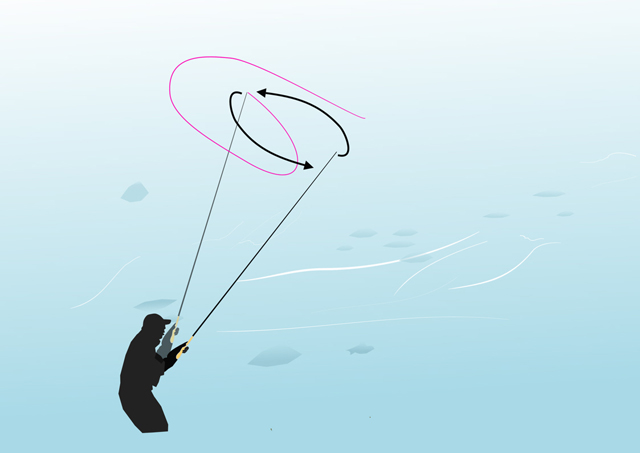
A great way to get the feel of the timing for this cast is to use Dr. Ishigaki’s casting drill. First of all (if you are right handed), hold your rod in your RIGHT hand and cup your right elbow with your LEFT hand. This will hold your elbow in a good and comfortable casting position.
Next, start to draw ovals in the air above your head so that your line “helicopters” around in continuous spirals (like a gymnast with a ribbon!). The idea is to get the feeling of the rod continually maintaining tension on the line.
Gradually make the ovals narrower and narrower – while keeping the motion and the tension on the line continuous. Eventually, the oval should become so narrow that it becomes basically a straight line backwards and forwards…
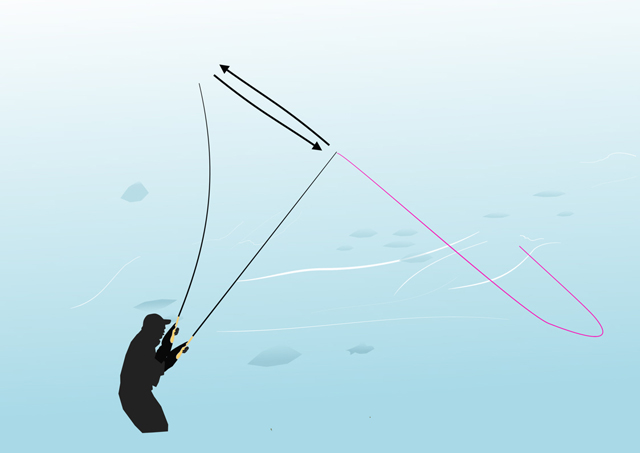
If you can keep the same timing, it will mean that there is no pause between the forward and backward cast (and there is no loss of tension or rod straightening before you change direction from forward to backwards during each casting stroke).
Tenkara Casting Level 3
This is another level of refinement – although of course there are many different technical casts that you can learn or invent for yourself. But if you can get good at the three levels outlined here, you’ll likely have no problem controlling your casting line in any way that you like.
This one is about damping out the rebound of the rod-tip – and it helps to smooth out and remove any bumps, wiggles or unwanted slack in the bottom leg of your casting loop.
It is something that is easy to write, but takes a bit more practice to learn to do. Maybe the best way to think about it is to imagine what happens when you press the brake pedal on your car…
If you press it down until you stop (and then keep the pedal pressed down) the car tends to “rebound” and jerk to a stop which is unpleasant for you and your passengers. Instead, you quite quickly learn to just release the pressure on the brake pedal at the very moment you are coming to a halt. This removes that jerk and allows you to come to a smooth stop.
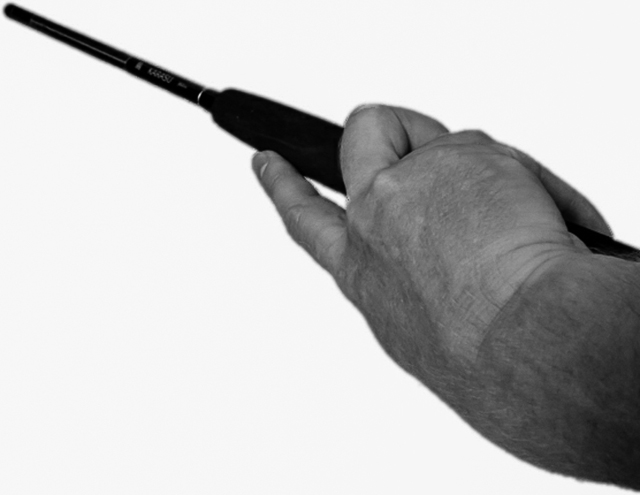
That is exactly what we need to do with our grip on the rod handle when casting! So if you take it in the following sequence:
1.) Start of back-cast 2.) Main part of back cast 3.) Finish of Backcast/Start of forward cast
Your grip should match each stage as follows:
1.) Relaxed 2.) Squeeze gently 3.) Relaxed
The exact same sequence should follow for your forward cast…The easiest way to say it is that you squeeze as the rod begins to move and then relax as the rod comes to the point where you change direction (or deliver the forward cast to the target).
Adapting your Tenkara Casting: The Traditional Stiff Rods and Horsehair line
By developing your sense of touch and ability to feel the rod loading and unloading (and to control or damp that motion by gently squeezing and relaxing your hand) it is possible to easily adapt to any different tenkara rod and line setup. This is why I was able to pick up Yamada-san’s stiff Gamakatsu rod and horsehair line and, right away, cast it reasonably accurately in Akiyamago when we first visited him in 2016.
And, although it will take a fair bit of practice, that sense of touch is also vital when learning the high line-speed/elbow-thrust style of casting favoured by Shokuryoshi (professional tenkara anglers) with their favoured stiff rods and relatively heavy twisted horsehair lines. Not only does that casting style allow for the use of stiff rods (and relies less on the deep loading of modern, full-flex tenkara rods), it also keeps the fly in the water for longer because the action is so fast and efficient. Those are important considerations when you are fishing to survive!
You can see the basics of this elbow-thrust (and also the crucial “rebound” of the elbow to a bent position which raises the casting line into the correct fishing position) on the video above. However, to learn this properly (and to get a genuine, solid basis to your tenkara) you’ll need to learn the tenkara of Hisanobu Hirata. As a lifelong professional he has had to rely on his tenkara skills to feed his family all his life – whether catching fish on bamboo rod and horsehair line for survival or through his tackle shop and tenkara school in Gifu Prefecture.
You can find out how to gain and incorporate Hirata-san’s skills and knowledge into your own fishing by Clicking below:
Paul
PS Please feel free to enlighten/enrage your friends by sharing this article on social media - or via direct link
